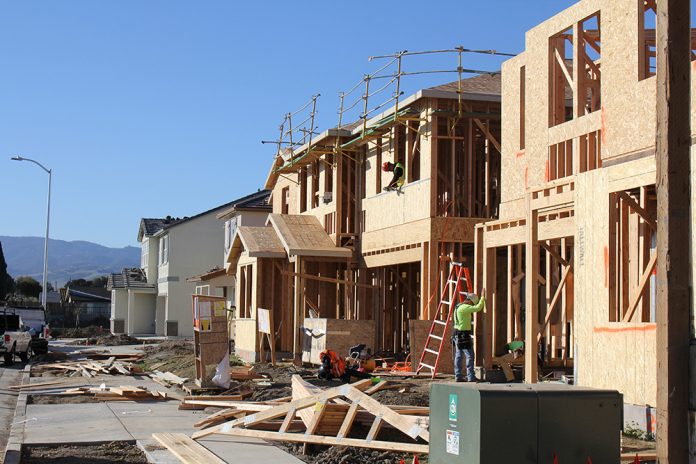San Benito County and the cities of Hollister and San Juan Bautista need to plan to build up to 5,005 new homes from 2023 to 2031—more than three times the number of houses permitted locally in the last eight years.
The planning directive comes from the California Department of Housing and Community Development’s Regional Housing Needs Allocation mandate. As part of RHNA, state officials determine the total number of new homes the San Benito region needs to plan for in order to meet the housing needs of people at all income levels, says a Council of San Benito Governments (COG) staff report.
The HCD announced San Benito County’s RHNA allocations in October. COG staff have been meeting with local jurisdictions in December, presenting the state’s allocation data and informing officials about the next steps.
At the Dec. 20 Hollister City Council meeting, COG Transportation Planner Veronica Lezama said the 2021 RHNA mandate does not mean the county and its jurisdictions have to build 5,005 new housing units before 2031. “However, they do need to lay the groundwork by having the proper zoning to streamline the process,” Lezama said.
The 2023-2031 time period is known as the “Sixth Cycle” for RHNA allotments. In San Benito County’s Fifth Cycle, which covered the period from 2016-2023, local RHNA allotments totaled 2,194. During that period, the county, Hollister and San Juan Bautista collectively permitted 1,598 homes, according to COG staff. That’s a buildout rate of more than 72% of allocated homes.
“The entire region has done quite well in constructing the units that were planned in the Fifth Cycle,” Beth Jarosz, Program Director for Population Reference Bureau, told the council.
Depending on which methodology COG approves early next year to arrive at 5,005 planned units, the City of Hollister will shoulder most of the allocation burden. More than half of the total eight-year allocation should be planned inside Hollister city limits, according to the three different methodologies presented Dec. 20.
The sheer number of allocations—more than twice the previous cycle—has city officials worried about how the local government can afford to keep public infrastructure in shape to accommodate that much growth. Council members noted that future residential planning in Hollister from now on will require higher-density, mixed use projects, as well as a slowdown in the approval of single-family homes that contribute to sprawl and skyrocketing costs.
Mayor Ignacio Velazquez, who is a COG board member, said local officials in the past have consistently caved to home developers who prefer to build lower-density single-family homes, and the result is higher housing costs for existing and longtime local residents.
“We need to make sure each project has higher density so we have higher mixed use in every community, along with the single-family homes,” Velazquez said at the Dec. 20 meeting. “We could, as a city, demand that any and all projects have a higher density. The density is key to this” RHNA plan.
He added that city officials will need to work more closely with the county in the coming years to coordinate more efficient housing plans. “It doesn’t mean we’re stopping growth, but we’re planning better,” Velazquez said.
City staff member Eva Kelly added, “In our current General Plan Update, the city’s goal is to keep moving toward infill (development of vacant urban parcels), high density (and) eliminating the sprawl that we’re seeing in the county.”
Although they don’t think they can change the state’s mind, council members agreed to draft and send a letter to HCD officials expressing their concerns about the massive 5,005-unit allocation. In addition to the lack of funding for infrastructure and transportation improvements needed to support such growth, council members are worried about the “gentrification” that is already happening with the abundance of expensive single-family homes, and the impact on the county’s agricultural lands.
The RHNA plan divides the county’s 5,005 allocations into affordability levels: 1,110 for very low income residents; 890 for low-income; 947 for moderate incomes; and 2,058 for above-moderate income residents.
The RHNA mandate became part of state housing law in 1969, in an effort to ensure local governments are planning for enough housing to accommodate future growth at all affordability levels.
The COG board will hold additional public hearings on the RHNA Sixth Cycle in the coming months, and is expected to adopt a methodology in January. The board is scheduled to adopt the final draft of the RHNA plan by summer 2022, according to COG staff.
When it is adopted, the housing plan will eventually be incorporated into the General Plans and Housing Element documents in each jurisdiction.
“The cities and county must update their Housing Element and General Plan to show how it plans to accommodate the regional (housing) need,” Lezama said.
BY THE NUMBERS
5,005: Regional Housing Needs Allocation, 2023-2031, for San Benito County, City of Hollister, City of San Juan Bautista
2,194: RHNA, 2016-2023, for same local jurisdictions
1,598: New homes permitted by county, Hollister, San Juan Bautista, 2016-2021










